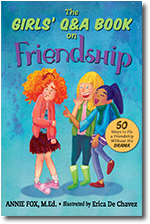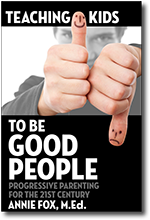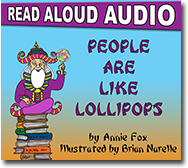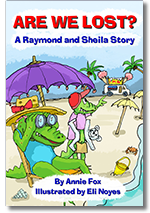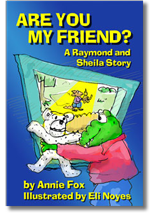|
|
December 28, 2012
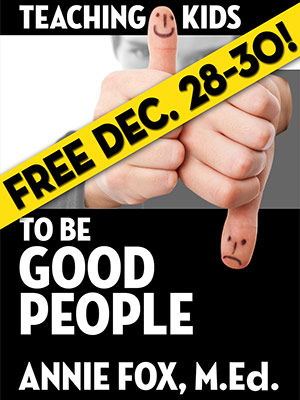 FREE download for December 28-30, 2012, ''Teaching Kids to Be Good People'' by Annie Fox, M.Ed. Today (12/28) through Sunday (12/30), we’re giving away the Kindle version of my new parenting book Teaching Kids to Be Good People: Progressive Parenting for the 21st Century.
No Kindle? No problem. Download the ebook anyway because you can read it just fine on your PC, Mac, iPod Touch, iPhone, iPad, Android, Blackberry, and Windows Phone 7 with Amazon’s free Kindle Reader app.
Not in the US? Here are the Amazon links for Canada, UK, Australia, Brazil, France, Germany, Italy, Japan, Spain
Please accept this ebook as my gift to you and your family. Interested in the print edition? Learn more here.
Best wishes for a happy, healthy New Year, from our home to yours.

December 26, 2012
My friend and digital kids’ author, Karen Robertson, whose work includes the Treasure Kai series plus the Author’s Guide to Book Apps, contacted me about “The Next Big Thing.” Essentially it’s a “blog chain” for writers to help fellow writers get some buzz about their latest books and/or upcoming projects. Anything that helps me promote my work and simultaneously allows me to shine a light on other people’s writing sounds like a winner. “Sure!” I told Karen. “I’m in.”
She sent me 10 questions to answer. She’s linking to my blog from hers and, in turn, I’m supposed to link to the blogs of writers to whom I’ve reached out. Only one snag. At the moment, none of the 10 writers I’ve pitched the idea to have responded to me. I chalk it up as part of a well-deserved holiday slacker attitude. (Not even sure why I’m blogging today, except that I promised Karen and I’m big on keeping agreements.) When my writer friends get around to reading the email I sent them a week ago and decide to jump into The Next Big Thing, I’ll update this blog and link to their sites. In the meantime, here are my answers to the 10 questions. It was fun to answer them. Hopefully, you’ll find something interesting in what I have to say here.
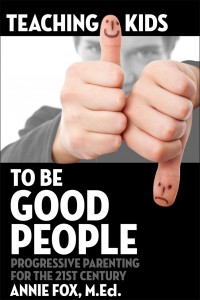 We can't parent without a game plan. Here's a good one. 1) What is the title of your latest book? Teaching Kids to Be Good People: Progressive Parenting for the 21st Century. It was published in October, 2012.
2) Where did the idea come from for the book? Well, we sure need more good people in the world. Can’t have too many of them… ever! But right at this point in history, I’d say we’re dealing with a world that is speedier, noisier, and in many ways more “I, Me, Mine” than ever before. Good people are desperately needed. Definition of a good person? Well, in my book… (and this is my book) a good person is one who looks for opportunities to do good in the world and has the social courage to act on those good intentions.
3) What genre does your book fall under? Non-fiction, parenting. But on a much broader level, this is a book about emotional intelligence and the tools to resolve issues from our own childhood so each of us may move forward toward a healthier relationship with ourself, our parents, our children, and everyone else. This may actually be a book about creating world peace. (Wow, that was a bigger answer than the “genre” question, wasn’t it?)
4) What actors would you choose to play the part of your characters in a movie rendition? I get that this question was devised for fiction writers, but I’ll take a sincere crack at it. Since the basis of my book is 32 personal essays, I’d say the best person to play the lead character in the movie rendition of Teaching Kids to Be Good People would have to be me. But I could totally do it! I was voted Class Actress in high school and I’ve done tons of community theatre. I already know all the lines, so I’m ready!
5) What is the one-sentence synopsis of your book? We desperately need more good people and they’re going to come from parents with a game plan. Teaching Kids to Be Good People is the game plan. (OK, that was two sentences. Sorry.) Here’s a free excerpt of Chapter 1, just to give you a taste of what this is all about.
6) Was your book self-published or represented by an agency? Electric Eggplant (which is my husband, David Fox, and me) published Teaching Kids… So, the answer is self-published. And I say that with no small amount of pride. The book looks and reads like the professional product it is.
7) How long did it take you to write the first draft of the manuscript? About a year, though many of the essays were originally written in other forms within the past five years. Two-thirds of the book is brand new content. Even with the “older” stuff, I had to get in there and re-work each essay because a) I’m a compulsive editor and b) I’m a better writer than I was when I first wrote them. I’ll be a better writer tomorrow than I am today. If I were to revisit this book a year from now, I’m sure I’d find ways to take it to still another level. But at some point you have to say, “This is good. I stand by it as is.” And then you put it out there in the world. I’m gratified by the enthusiastic reviews the book has received so far.
8) What other books would you compare this story to within your genre? There are hundreds of top-notch parenting books out there, with more coming to market each month. It’s a very competitive genre to be publishing in. Many of these books are written by MDs, and PhDs and are very helpful to very specific parenting challenges like: parenting kids with special needs, parenting adoptive kids from “hard” places, step-parenting, etc. My book is for all parents who recognize that their #2 objective (after keeping their children safe and healthy) is to help kids develop into people of good character.
9) Who or what inspired you to write this book? I’ve been answering email questions from tweens and teens since 1997. More and more of their questions reflect a huge gap in their understanding of how to treat themselves and others with compassion and respect. I wrote the book because kids have told me (in so many words) that they need tools to help them develop a moral compass. I wrote the book to help parents help their kids on their journey into young adulthood and beyond. A big part of the challenge parents have is in the area of communication. We wrongly assume that adults and kids mean the same thing when we use words like “fair” “mean” “love” “trust” “friendship.” That ain’t necessarily so. Parents need to do whatever it takes to get on the same page as their children (no small feat when our kids spend 24/7 mind-melded with their peers). My book offers parents new ways to see 21st century life from the eyes of their kids and provides guidelines to Conversations that Count. We need to listen to each other so a kid’s perspective is part of every parent’s frame of reference and a parent’s perspective is part of the mix inside a kid’s head when s/he is making choices amongst peers.
10) What else about the book might pique the reader’s interest? Read it and you’ll learn more about yourself and your kids. Then you’ll be able to use what you learn to be the kind of parent you have always wanted to be.

December 15, 2012
 We have the right to be safe There’s nothing more “right” than a child’s right to go to school in the morning and learn to read so she can open wide the windows in her mind and dream about the world and her place in it.
All children have the right to be loved and encouraged by their parents and teachers.
All children also have the right to be accepted by their peers, to play, and to come home safely to be with their family in the evening. And yes, all children have the right to sweet dreams. Sweet dreams are exactly right for children.
But last night, no parent who knew about Sandy Hook had sweet dreams. Not likely many children did either.
Something very wrong happened again. It’s been happening in America for a long time. It’s always hard to take it in, but we are experts at distracting ourselves. If it didn’t happen in our family, in our community… we forget.
It’s getting harder to forget.
But, as a nation, we are way past tongue-clucking, “what-a-tragedy” small talk. It’s absurd to pretend otherwise. It’s not as if we have no clue how to fix the problem. We know what to do to make it much less likely that another one of these will happen again. Does anyone really need to spell it out? OK. I’ll do it:
We have to do a better job identifying and reaching out to the troubled people amongst us (kids, teens, adults) and get them the professional help they need so they can feel “a part of” rather than “apart from” the rest of life. The rest of us will be safer.
We also need to reasonably restrict access to guns. There. I’ve said the four-letter word. Let the NRA come get me. I’ve got no gun here, so I’ll be an easy target. But please don’t bother posting comments about 2nd amendment rights. No hunter needs an assault weapon to shoot a target or a rabbit. Only a hunter of people needs an assault weapon. He has no license to kill so I don’t give a good goddamn about his rights.
I care only about the rights of children and the parents and teachers who love them. For those of you at a loss for the words to talk with your children about this tragedy, here is an excellent resource from the National Center for School Crisis and Bereavement. (The fact that we even have such a place tells a lot about our current culture.)
Now please, email your Congressional representatives today and urge them to reinstate the federal Assault Weapons Ban. Sign this petition urging an Assault Weapons Ban. If you’re as fed up with the NRA’s strangle hold on common sense gun reform as I am, here are some other things you can do, right now, to end gun violence. We have the collective power to do the right thing. ‘Bout time we got together and used it.

December 10, 2012
by Carolyn Fallon
Carolyn is a 20-something year old with a passion for life, fitness and overall well-being. She is an avid cycler, golfer and has known to bust some serious moves on the dance floor. To learn more about Carolyn, please check out her blog.
I never paid attention to the topic of Type 2 Diabetes. All of that changed when my little cousin was diagnosed. As I have recently started on my own journey to live a healthier life, it has become even more important to me that I help all my cousins learn how to be healthier. Because the two most common causes of Type 2 Diabetes are obesity and lack of physical activity, I’ve been helping my cousins get on a healthier track through tips on nutrition and exercise.
Dietary Habits
The typical mantra is that anything that tastes good tends to be bad for you. Although this may seem true, it doesn’t have to be! My cousins love their junk food. To prevent them from feeling totally deprived of the things they liked, I found creative ways to allow them to indulge in these foods in small moderation. I’m also helping them find ways to make healthy foods taste yummy too. Here are some popular changes I made that will work for you and your family too:
– add grilled vegetables to any meal and you get great flavor and large variety
– add fruit to meals. (Cut ’em into fun shapes!) By getting my cousins involved in making smoothies, etc. they were way more accepting of fruit in general.
– switch from white flour bread to whole grains-products
– use mashed cauliflower instead of potatoes
– use spaghetti squash instead of pasta noodles
There are so many ways you can get kids to start eating healthy if you are willing to get a little creative.
 Get moving!
Get Moving!
It’s so important to get kids in the habit of being regularly active. My cousins tended to spend a majority of their time in front of the TV. To get them excited about exercise, I had to get creative. I found ways to make being active seem like a game instead of just getting exercise. Now we are…
Jumping Rope – A fun activity that many kids enjoy, and can be done alone or with others. We like to do jump rope competitions, or do large-group jump rope games too.
Swimming – Check out the public pool at your local YMCA or community center. Then get in the water with the kids! We do “Olympic trials” for the different kinds of strokes and we also play fun, calorie burning games like Marco Polo and water volleyball. Swimming often appeals to overweight kids because the buoyancy of the water takes the weight off of their joints. It also helps to build cardiovascular strength and endurance, which is good for all age people!
Running or Jogging – Most kids love to run. They may love it more if you make it competitive. My cousins and I like to do timed-races against each other, or our own time. We also play games that involve running, such as tag, Capture the Flag, soccer, kickball, etc.
Doing Yoga – Many kids find yoga to be a rewarding activity that helps them become more flexible and promotes endurance. My cousins were hesitant to try it, but once they got started, they really liked learning the different poses.
Be proactive! It’s scary to think that my little cousin is facing Type 2 Diabetes at such a young age. According to St. Joseph’s Hospital Cardiac Center, potential complications can include such things as eye problems or blindness, heart disease, stroke, neurological problems, and more. With so many possible serious consequences, it’s important that today’s families work together for better health that will help prevent the spread of this epidemic.
 — Older Posts »
| |








